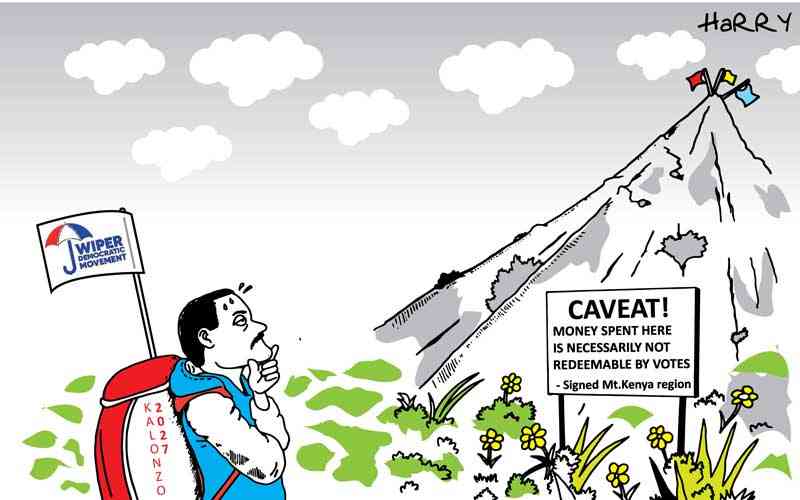During my high school days, English literature was one of my favourite subjects.
My literature teacher, Mwebe Lwanga Simon Claude- a strange name considering people hardly use their baptismal name after their African surnames-was a Ugandan who had escaped from the treacherous hands of Uganda’s dictator, Idi Amin.
He was a great inspiration. In its hey days, Garba Tula School in Isiolo county was the equivalent of today’s Moi High School Kabarak. Majority of students who studied there in the 1980s qualified to join the universities, making it a school of choice for many primary school leavers.
Today the school is in a deplorable state. Its performance is wanting. Nevertheless, my intention is not to discuss this once prestigious school. The fact is that the lessons I learnt from there still linger in my mind. More specifically, the lessons I learnt from Mwebe Lwanga help me contextualise Kenya’spolitical landscape today.
Two such lessons that have significantly made me understand human communication and its significance in story telling is the use of allegories and the functions of onomatopoeia. According to Levi Strauss allegory is a literary device in which a character, place or event is used to deliver a broader message about real-world issues and occurrences. Onomatopoeia is the use of sounds to depict the actions of a character in a story.
The hyena
From Somali folklore, I remember the stories my mother used to whisper into my ears when putting me to bed. I still practice this habit learnt from my mother to date with my children. I whisper the same stories, not only as lullabies but also to teach them our traditions.
One story that I like narrating is that of the lion and the carcass. Once upon a time there lived a group of animals in the jungle. The lion was their king. One fine morning, the lion roared and instructed the hyena to dismember a carcass and share it out with other animals. The hyena gladly obeyed. He divided the carcass into two parts and said: “Your majesty, take one half, the rest of us will share the other half.”
The lion was very angry at the suggestion. He roared and slapped the hyena so hard that one his eyes popped out. The lion then asked the fox to share out the carcass. The fox decided to give the lion half of the carcass, and then added him another portion, then another portion until only a small portion was left for the rest of the animals. This pleased the lion very much. He roared and roared and asked the fox: “Where did you learn to share out a carcass so well?”
The fox replied that he had learnt from the slap meted out on the hyena. The lion praised the fox for being very wise and happily devoured the huge portion of carcass he had been given. The rest of the animals where very angry, but afraid to confront the lion. They vowed that one day they would teach the lion a lesson, especially when he grew old and weak.
Nigerian proverb
What is the moral of the story and how does it fit into our political context today? Juxtaposing the story with the politicaldynamics of Kenya today might not be very fair, but in African folklore, allegories are used to describe real situations, albeit politely, so that no one gets offended.
Take the example of the Nigerian proverb that says when the hyena wants to eat its young, it accuses it of smelling like a goat. This proverb describes situations where betrayals are justified. In politics, this happens very often.
The challenges within Jubilee Party and the handshake between Raila Odinga and President Uhuru Kenyatta can be analyzed through the prism of African folklore. Of course, allegories are used in many African fireside stories, but no link is made to the people they refer to in real life. But let me use our modern democratic space to assign the characters in the allegory of the lion and the carcass.
Since 2013, within Jubilee, the lion (read Uhuru Kenyatta) gave the task of dismembering the carcass to the hyena (read William Ruto). Through the handshake (read the hard slap) the eye of the hyena is gorged out.
Stay informed. Subscribe to our newsletter
Then the fox (read Raila Odinga), cunning as usual, offers to assist in sharing the carcass and allowed the lion to keep ‘the lions share,’ so to speak. There is a possibility that the fox and hyena, both angry with the lion, might gang up to find their own carcass or simply team up against the lion.
Mr Guleid is the Executive Director of the Frontier Counties Development Council
 The Standard Group Plc is a
multi-media organization with investments in media platforms spanning newspaper
print operations, television, radio broadcasting, digital and online services. The
Standard Group is recognized as a leading multi-media house in Kenya with a key
influence in matters of national and international interest.
The Standard Group Plc is a
multi-media organization with investments in media platforms spanning newspaper
print operations, television, radio broadcasting, digital and online services. The
Standard Group is recognized as a leading multi-media house in Kenya with a key
influence in matters of national and international interest.
 The Standard Group Plc is a
multi-media organization with investments in media platforms spanning newspaper
print operations, television, radio broadcasting, digital and online services. The
Standard Group is recognized as a leading multi-media house in Kenya with a key
influence in matters of national and international interest.
The Standard Group Plc is a
multi-media organization with investments in media platforms spanning newspaper
print operations, television, radio broadcasting, digital and online services. The
Standard Group is recognized as a leading multi-media house in Kenya with a key
influence in matters of national and international interest.









